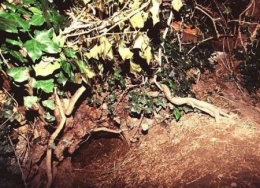
Photograph © Copyright of Mike Brown Photography
DescriptionThe badger is one of our largest, most distinctive and possibly best loved mammals. Badgers are heavy, thick-set animals with powerful limbs. Easily recognisable, the head is white with two vertical black stripes from ears to below the nostrils. The rest of the body is grey but in there may be variations. Erythristic badgers can occasionally be seen. Instead of the usual grey colouring, the coat is sandy colour, often deepening to a more reddish tone. Albino badgers are more rare. They too lack the melanin pigment and are pure white. Badgers usually weigh slightly under three stone but sometimes more. The average body length is about three feet from nose to tip of tail. Like many mammals, badgers have two coats of fur; a short stiff undercoat for warmth and a longer layer of coarser guard hairs, the colour of which give the badger its striking appearance. They moult throughout the summer. DistributionThe badger is found throughout the temperate parts of Europe and Asia, from Ireland in the West to Japan in the East. It is found in all European countries including some of the Mediterranean Islands (Crete and Rhodes), only being absent from the most northern parts of Scandinavia and Russia. Ireland and England have the healthiest populations (at present). Population in IrelandDr. Chris Small's "The Badger and Habitat Survey of Ireland" which was completed more than a decade ago and published in 1995, "estimated" the population at 200,000 in the Republic with a further 50,000 in Nothern Ireland. Thousands are killed on roads every year and it may be safe to assume that many more are killed illegally i.e. on farms and also by people involved in badger digging and baiting activities. It is ackowledged that the cub mortality rate is high with only half surviving the first year of life. Legal snaring by the department of Agriculture, Food and Rural Development (DAFRD) may seriously threaten the present population. DAFRD has legally snared many thousands of badgers, under licence from Duchas in the last decade because of their yet unproven role in the spread of Bovine TB. In a four year project, which ends circa 2006, DAFRD plans to eradicate 30% of our native badger population. DietBadgers are omnivorous, eating both plants and flesh. The mainstay of the badgers diet, in northern Europe, is the earthworm. However, they eat an extremely wide variety of foods, depending on what is available locally. Their diet also includes :
In southern Europe, the badger eat mostly insects and fruit. In the height of the summer, when the ground is at its hardest, earthworms move further underground, making it more difficult for badgers to find them. It is at this time that badgers are at their lightest.  Sketch © Copyright of Eunice Overend HabitatBadgers live in large underground tunnel systems called setts. There are normally 3 to 10 entrances to these setts, which are much larger than rabbit holes (at least 25cm or 10") and oval in shape. The entrance can sometimes be spotted by the presence of old bedding and excavated material outside and are often built into banks.
Badgers are very territorial and defend an area of 50 to 150 hectares encompassing the main sett, annexe setts and foraging areas. The boundaries of the territory are usually outlined by well-worn paths as are the routes between the main sett, any annexe setts and the foraging areas. Badgers mark these paths with scenting by using latrines that they regularly use. Like all Mustelids, badgers secrete a very odorous scent from their subcaudal glands, that they use for scenting their paths and latrines. Behaviour and ReproductionBadgers are nocturnal, coming out at night to play and feed. They live in social groups that typically consist of about 6 badgers, sometimes called clans. These clans consist of a dominant male, a dominant female and their subordinate offspring. Mating may occur anytime after the sow has given birth in January to March, up until September. This means that a variable period of gestation of between 2 and 9 months follows, make possible by delayed impregnation. The fertilised egg develops into the blastocyst (a ball of cells), but doesn't implant into the womb during this period and hence its development is paused. This delayed implantation is also exhibited by other Mustelids and recent research suggests that it may be triggered by hormone levels that are effected by the ratio of daylight to darkness hours. When the true gestation period starts, the sow prepares the birth chamber, located in part of the sett where she will have minimum disturbance. Preparation of the chamber involves airing or replacing the bedding (bracken, hay or other such material) from the chamber. After 7-8 weeks of gestation, the sow gives birth to 1-5 cubs, but 2-3 is more usual. The cubs are about 6 inches long (15cm), weigh just 3-5 oz (80-130 grams) and look like miniature versions of the adults. Their eyes remain closed for 2-5 weeks and they will suckle for about 3 months. The cubs first venture above ground after 8-10 weeks in early summer, making summertime a great time to watch badgers. During this time, the sow teaches the cubs how to feed themselves and how to catch prey. Cubs stay with the sow until autumn and sometimes winter but are independent after 16 weeks. Badgers don't hibernate over winter, but are less active and may spend several days below ground during periods of bad weather. The cubs do not disperse from the sett until the following spring and DNA analysis has shown that many never leave (female are more inclined to stay than males). This dispersal is unfortunately responsible for the increase in badger road every spring. Badgers live for over 10 years to 12 years and there is a case of one living for 15 years. Copyright 2008 by Badgerwatch Ireland. All rights reserved. |
